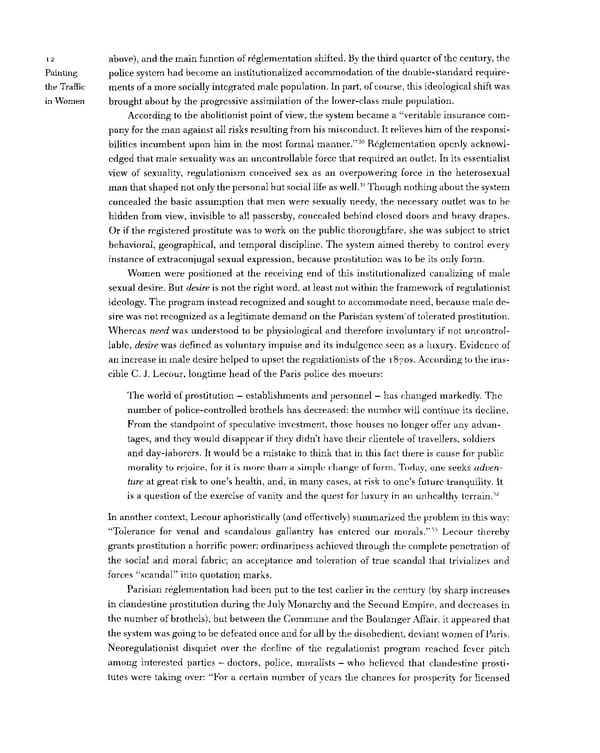12 above), and the main function of reglementation shifted. By the third quarter of the century, the Painting police system had become an institutionalized accommodation of the double-standard require- the Traffic ments of a more socially integrated male population. In part, of course, this ideological shift was in Women brought about by the progressive assimilation of the lower-class male population. According to the abolitionist point of view, the system became a "veritable insurance com- pany for the man against all risks resulting from his misconduct. It relieves him of the responsi- bilities incumbent upon him in the most formal manner."50 Reglementation openly acknowl- edged that male sexuality was an uncontrollable force that required an outlet. In its essentialist view of sexuality, regulationism conceived sex as an overpowering force in the heterosexual man that shaped not only the personal but social life as well.31 Though nothing about the system concealed the basic assumption that men were sexually needy, the necessary outlet was to be hidden from view, invisible to all passersby, concealed behind closed doors and heavy drapes. Or if the registered prostitute was to work on the public thoroughfare, she was subject to strict behavioral, geographical, and temporal discipline. The system aimed thereby to control every instance of extraconjugal sexual expression, because prostitution was to be its only form. Women were positioned at the receiving end of this institutionalized canalizing of male sexual desire. But desire is not the right word, at least not within the framework of regulationist ideology. The program instead recognized and sought to accommodate need, because male de- sire was not recognized as a legitimate demand on the Parisian system'of tolerated prostitution. Whereas need was understood to be physiological and therefore involuntary if not uncontrol- lable, desire was defined as voluntary impulse and its indulgence seen as a luxury. Evidence of an increase in male desire helped to upset the regulationists of the 18705. According to the iras- cible C. J. Lecour, longtime head of the Paris police des moeurs: The world of prostitution — establishments and personnel — has changed markedly. The number of police-controlled brothels has decreased: the number will continue its decline. From the standpoint of speculative investment, those houses no longer offer any advan- tages, and they would disappear if they didn't have their clientele of travellers, soldiers and day-laborers. It would be a mistake to think that in this fact there is cause for public morality to rejoice, for it is more than a simple change of form. Today, one seeks adven- ture at great risk to one's health, and, in many cases, at risk to one's future tranquility. It is a question of the exercise of vanity and the quest for luxury in an unhealthy terrain.52 In another context, Lecour aphoristically (and effectively) summarized the problem in this way: "Tolerance for venal and scandalous gallantry has entered our morals."55 Lecour thereby grants prostitution a horrific power: ordinariness achieved through the complete penetration of the social and moral fabric; an acceptance and toleration of true scandal that trivializes and forces "scandal" into quotation marks. Parisian reglementation had been put to the test earlier in the century (by sharp increases in clandestine prostitution during the July Monarchy and the Second Empire, and decreases in the number of brothels), but between the Commune and the Boulanger Affair, it appeared that the system was going to be defeated once and for all by the disobedient, deviant women of Paris. Neoregulationist disquiet over the decline of the regulationist program reached fever pitch among interested parties - doctors, police, moralists - who believed that clandestine prosti- tutes were taking over: "For a certain number of years the chances for prosperity for licensed
 Prostitution & Impressionists Page 32 Page 34
Prostitution & Impressionists Page 32 Page 34